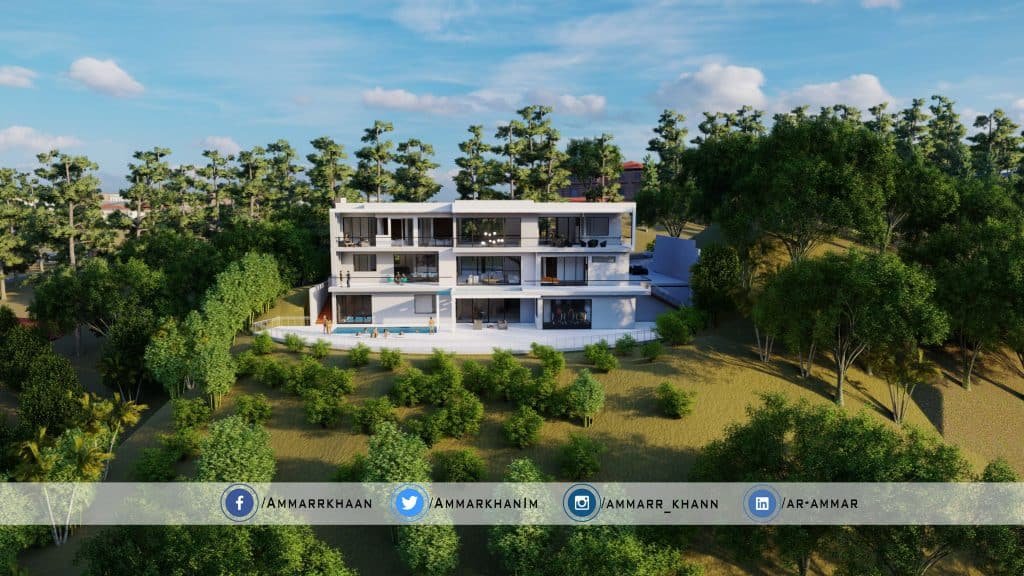
Rendering is the process of forming a 2D or 3D photo-realistic image of any property or building before it has been built. It transforms non-realistic images into photorealistic images/Videos.
And its final look is much like that taken from a traditional camera that most the clients can't tell the difference between the real photo and 3D rendering.
That time is gone when architects relied on sketches and hand drawing to showcase their designs to clients. Today, they form a 3D model or animation through rendering to bring their idea into existence.
“Rendering opens the door to the virtual world”
Before rendering, the designer adds all the distinct parts in the 3D images like animating furniture, building, trees, and more. After generating the 3D image rendering starts.
Rendering adds the simulation of the realistic atmosphere, lighting, shadow, and optical effects to the image. Therefore, the 3D building will be formed, now you can see how the building will look before the construction.
Types of Architectural Rendering
Today, 3D architectural rendering is an important tool that helps the modern artist to demonstrate their ideas to clients and allow them to experience the realistic view of their project.
These photorealistic images /Videos made it easy to explain the idea as well as impress the audience at any stage of the project.
Here are the important types of architectural rendering that assist to convey all aspects of the design.
- External 3D Visualization

External 3D visualization is used to portray the external view of the building from different angles.
Multiple angles show each part of the building which illustrates the uniqueness of the projects to the client or the audience. This gains the trust of potential clients. Thereby, it helps to approve the design and gather money for the construction.
External visualization gives the feeling to potential investors that how it will look in real life before it goes under construction.
It is usually used in real estate and architecture to showcase the project.
External visualization offers to convey the idea of any design to fit into any project. Therefore, it establishes an emotional bond between the artist and the audience.
- 3D Interior Visualization
Interior visualization plays a vital role in showcasing the still images of any particular layout of interior space that is important for the advertising or selling of interior spaces.
3D Interior visualization allows the designer to exhibit the position of furniture, appliances, and structural components in the proposed space. Thereby, it brings coziness, liveability, and spaciousness to the design to their client.
That way, designers use interior rendering to convey every aspect of design, from the layout, texture, color, atmosphere, and every detail.
Today, the client prefers a 3D model to see how the furniture or every element of interior space will look in real before organizing it.
- CG Panoramas
CG panorama is an advanced type of architectural rendering. It is an interactive 360-degree experience of any design, where the viewer can experience every aspect of space in real life.
This rendering takes more time and effort but it is way better than any other rendering type.
It allows the potential buyers to endure the overall effect, explore the space, go through every single aspect and determine if the place is according to their needs. Their experience is so immersive that it makes them want to do an instant investment.
CG panorama transforms the 2D image into a 3D visualization and it requires as much work as 2 or 3 regular renders.
- 3D Animation
This type of rendering is like watching a short movie, where the design plays the main plot.
The camera smoothly glides through different scenes and goes into every tiny detail. This is the finest way to show the design to the client because it is more real and expressive than a CG panorama.
3D animation uses hundreds of thousands of still images to give it a movie-like effect.
Any company or designer who wants to leg up their designs uses 3D animation because it covers every angle, detail, space, and feature of the property.
Moreover, to grab the client's attention, a designer can add background music, voiceover, text, and logo to make things more appealing.
- Virtual Tour
The virtual tour is the most efficient of all types. It gives the most immersive experience that no other type can come even close to it.
A virtual reality tour is a set of panoramic photos in series that form a video that involves sound and text.
Virtual reality tour helps to win the vote of confidence of the client by offering the utmost realism and every single detail of property from different angles.
It is required in construction too because it reduces the chances of making mistakes, Thereby, a huge amount of money, time, and effort can be wasted.
This content display can be shareable through any communication channel wherever the client prefers.
CONCLUSION
All these 3D rendering types are important for creating strong plans that are used by designers for marketing and promoting purposes.
All these tools help the designer to convert the idea of the client into a natural and liveable form.
Meanwhile, the virtual tour and the panorama are considered the favorite types in presenting the design because they both give more control to the client for the exploration of the design.
The more immersive experience the client has, the more trust will build between the client and the designer.


Pingback: THE BEST LAPTOPS FOR LUMION - Ammar Khan
Pingback: BEST GRAPHICS CARDS FOR 3D RENDERING 2021 - Ammar Khan
Pingback: The Best CPU For 3D Rendering 2021 - Ammar Khan
Pingback: What is PBR texture? - 3DHEVEN
Pingback: Simple Interior Design With Lumion - Ammar Khan